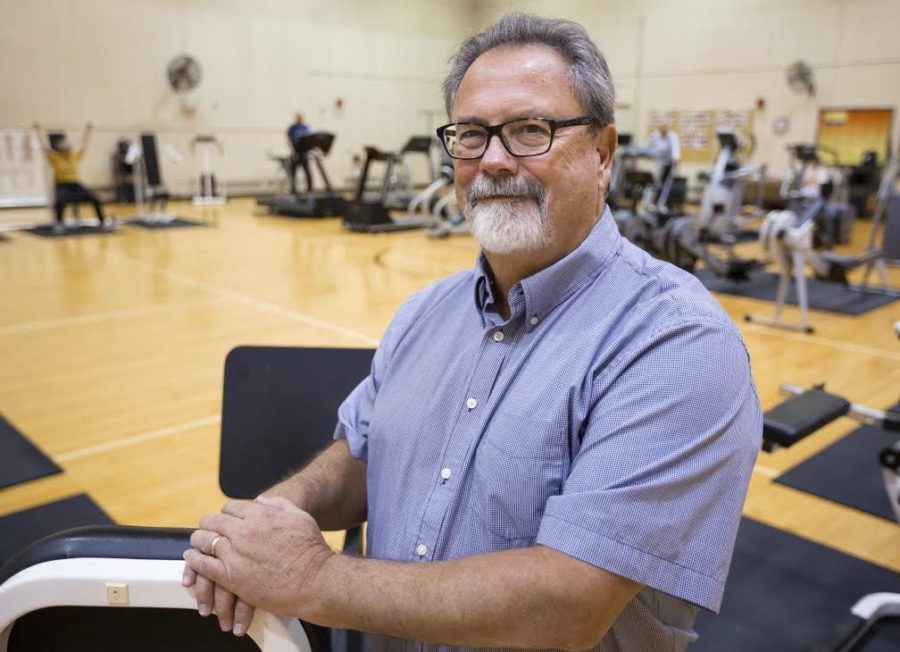ISU research improving muscle retention, growth in older adults
Rick Sharp.
September 10, 2015
Every muscle in your body expands and contracts to make daily movements, from a blink to a leap, possible. An ISU professor is studying the effects of dietary supplements and exercise on keeping these muscles working better for longer.
He started early. When he was still in school, Rick Sharp, professor of kinesiology, remembers having a conversation with his grandmother about his interest in muscle function.
“She said, I don’t know what it is you’re going to do, Rick, but as long as you can help me figure out how to open a mayonnaise jar when I’m in my 80s, I’ll be happy,” Sharp said.
Sharp is studying the combined effects of exercise, vitamin D and a natural body-building compound called b-hydroxy-b-methylbutyrate, or HMB, on fighting muscle loss in older adults.
This aging-associated muscle loss is called sarcopenia, and Sharp said the condition poses significant problems with physical ability and quality of life for many older Americans.
John Rathmacher, assistant professor of animal science, said that previous studies have shown a peak muscle mass in average adults between 40 and 50 years old. After that, he said, muscle tissue breaks down faster than the body synthesizes proteins for new muscle, and the result is a loss in muscle mass and strength.
“It’s tougher for older adults to put that muscle mass back on, especially if they suffer from chronic diseases, injuries or pain,” Rathmacher said. “If a person who has already lost muscle falls and breaks a hip, it becomes even harder for them to do the exercises to prevent further loss.”
Sharp and Rathmacher said studies have shown positive effects on bone density and muscle mass from exercise or supplements of HMB alone, but this study is the first to add vitamin D.
Matthew Rowling, associate professor of food science and human nutrition, has studied established functions of vitamin D extensively. Vitamin D is naturally synthesized by our bodies with exposure to sunlight and it has long been known to regulate the amount of calcium in blood and bones.
“Most people get vitamin D from the sun or dietary supplements because it’s not really prevalent in food,” Rowling said. “There are receptors for it all over our muscles, but we’re still learning a lot about vitamin D and how it relates to other things.”
Sharp said research is showing new uses for vitamin D in nearly every body system.
“We’re learning more all the time,” Sharp said. “In the old days we just thought it was useful for bone health. Now we’re seeing all types of potential applications.”
In his research, Sharp records information on all his study participants’ activity levels, medications, diets, past injuries and responses to experimental HMB/vitamin D supplements and controlled fitness regimens.
Sharp said variations in the participants’ lifestyles may also affect his data, but he hopes to record this additional information in a way that inspires further research.
“Nothing’s ever lock solid proof of anything else,” Sharp said. “We’ll probably never get to a point where we can have a 100 percent watertight recommendation for anybody … but you do these studies, try to control the things you can and measure some of the things that you can’t so that you can use them as explanatory factors.”
Sharp said there’s already enough evidence to know it’s a good idea to exercise and eat a balanced diet throughout life, but he hopes this study will lead to more concrete recommendations.
“When your research can end up being available to the public, and provide them with something that’s potentially effective and helping them to live their lives, then that’s a gratifying thing,” Sharp said. “It’s one thing to live to be 90. It’s another thing to live well and be 90, and that’s what we all want to do, isn’t it?”
Even professional athletes can suffer from sarcopenia as they age. Dancer and choreographer Valerie Williams has nearly 50 years of anecdotal experience and has watched many of her colleagues stop dancing long before she did. Now at the age of 60, Williams stopped dancing full time two years ago. She said she has noticed some changes in her body despite leading a local dance troupe, teaching at Iowa State and dancing on a regular basis.
“I’m carrying 20 pounds more than when I was dancing full time, and that I can feel,” Williams said. “Getting off the floor while carrying 20 more pounds than I’m used to is work.”
Still, the slender, red-haired woman said people frequently underestimate her age by 20 years, and she said she plans to keep dancing as long as possible.
“If you move like you’re 20 when you’re 20 and keep doing that, you’ll always move like you’re 20,” Williams said with a smile. “But you can’t start moving like you’re 20 when you’re 50.”







